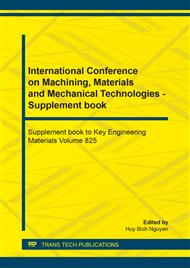p.96
p.104
p.112
p.126
p.133
p.140
p.149
p.158
p.164
Research on the Design of the Laser Beam in SLS Rapid Prototyping Machine
Abstract:
Selective Laser Sintering (SLS) is an HYPERLINK "https://en.wikipedia.org/wiki/Additive_manufacturing" \o "Additive manufacturing" additive manufacturing (AM) technique that uses a HYPERLINK "https://en.wikipedia.org/wiki/Laser" \o "Laser" Laser as the power source to HYPERLINK "https://en.wikipedia.org/wiki/Sintering" \o "Sintering" sinter powdered material, typically HYPERLINK "https://en.wikipedia.org/wiki/Nylon" \o "Nylon" nylon/ HYPERLINK "https://en.wikipedia.org/wiki/Polyamide" \o "Polyamide" polyamide HYPERLINK "https://en.wikipedia.org/wiki/Selective_laser_sintering" \l "cite_note-1" [7], HYPERLINK "https://en.wikipedia.org/wiki/Selective_laser_sintering" \l "cite_note-2" [8]. A Laser beam HYPERLINK "https://en.wikipedia.org/wiki/Automation" \o "Automation" automatically aims at points in space defined by a HYPERLINK "https://en.wikipedia.org/wiki/3D_modeling" \o "3D modeling" 3D model, binding the material together to create a solid structure. In the SLS rapid prototype machine, a high power CO2 Laser sources is applied for sintering the powder material to its melting point temperature. The ability of application of a Laser radiation for sintering the material depends on the power of energy source and the time of interaction of radiation with the material of the product. Otherwise, the design of Laser beam for sintering powder material depends on the technical parameters such as power Laser source, Laser point size, type and focus of lenses.... This article presents a study on the design of our own Laser beam sintering in the SLS rapid prototype that satisfies the technical requirements. The results of testing show that the designed and manufactured Laser beam instrument in SLS rapid prototype machine in our laboratory can be approved because it satisfies all the technological requirements of the medium range of SLS rapid prototyping machine.
Info:
Periodical:
Pages:
140-148
Citation:
Online since:
September 2019
Authors:
Keywords:
Price:
Сopyright:
© 2019 Trans Tech Publications Ltd. All Rights Reserved
Share:
Citation:


